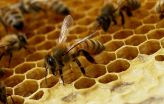(Press-News.org) This news release is available in Japanese.
An international research team has some good news for the struggling honeybee, and the millions of people who depend on them to pollinate crops and other plants.
These valuable pollinators have faced widespread colony losses over the past decade, largely due to the spread of a predatory mite called Varroa destructor. But the bees might not be in as dire a state as it seems, according to research recently published in Nature Communications.
Researchers found a population of wild bees from around Ithaca, New York, which is as strong today as ever, despite the mites invading the region in the mid-1990s.
"They took a hit, but they recovered," said Alexander Mikheyev, a professor at the Okinawa Institute of Science and Technology Graduate University (OIST) in Japan and lead paper author. "The population appears to have developed genetic resistance."
Mikheyev and his collaborators at OIST and Cornell University studied the population genetics of the wild colony by comparing the DNA of specimens collected in 1977 with bees collected from the same forest in 2010. To conduct the study, they developed a new DNA analysis tool that works especially well for degraded DNA stored in museum samples.
Such a study is extremely rare, especially with bees. Few people collect them, and even fewer collect in a way that is good enough for a population level study. Luckily, Cornell Professor Tom Seeley worked in this area during his Ph.D., and deposited his samples in the Cornell University Insect Collection. This is the first time scientists have been able to observe genome-wide changes after a specific event like the mite invasion.
"By using museum specimens, we see how evolution happens as compared to how we think it happens," said Mikheyev, who runs OIST's Ecology and Evolution Unit.
Many people think of evolution happening over thousands or millions of years, but in fact, it is happening from generation to generation. External forces cause certain traits to be selected and passed on to offspring to enhance their chance of survival and reproduction. By comparing bees from the same colony only a few decades a part, the team was able to see this natural selection in action.
The bees changed in several different ways.
First, mitochondrial DNA, the genetic material stored in cells" power plants, changed significantly from the older generation to the newer generation. That genetic material is only passed on from the mothers, so a major change indicates the old queen bees were wiped out and there were large-scale population losses. Even so, the population still maintained a high level of genetic diversity throughout the rest of genome, which is stored in the cell nucleus. Genetic diversity is the raw material for evolution, and high genetic diversity increases the chance for successful adaptation.
One of the most interesting changes in the bee population was in a gene related to a dopamine receptor known to control aversion learning. Another study has suggested this receptor is involved with bees grooming themselves to get rid of the mites by chewing them up.
The researchers also found many changes in genes associated with development. Mites reproduce and feed on the bee during the bees" larval stage, so the researchers hypothesize that bees evolved to disrupt that process. Also, there were physical changes " today's bees are smaller than the older bees and their wing shape is different.
The researchers note changes observed cannot be prescribed to any one factor, such as the mites, because the timeframe is too long. However, many of the changes are too large to be due to random genetic fluctuations, or the introduction of genes from other sources, like Africanized bees, and found the strongest driver of the observed changes was still natural selection.
"These findings identify candidate genes that could be used for breeding more resistant bees, such as the dopamine receptor gene," Mikheyev said. "More importantly, it suggests the importance of maintaining high levels of genetic diversity in domestic bee stocks, which may help overcome future diseases."
INFORMATION:
Current international disease surveillance systems are mainly based on reports made by doctors after treatment of infected patients. As a consequence, disease-causing microorganisms and resistance bacteria have time to spread and make large population groups sick before they are detected.
There is currently only very limited information about the global occurrence and transfer of antimicrobial resistance and infectious diseases.
Researchers at the National Food Institute and DTU Systems Biology are working to develop faster methods to detect and respond to outbreaks ...
Scientists at VIB and KU Leuven have shown that blocking the PHD1 oxygen sensor hinders the activation of p53, a transcription factor that aids colorectal cancer (CRC) cells in repairing themselves and thus resisting chemotherapy. Chemotherapy resistance remains a major clinical issue in the treatment of CRC. These findings indicate that PHD1 inhibition may have valuable therapeutic potential. The study was published in the leading medical journal EMBO Molecular Medicine, which features molecular biology-driven research.
Chemotherapy remains the most widely used cancer ...
Safinamide (trade name: Xadago) has been available since February 2015 as add-on therapy for the treatment of mid- to late-stage Parkinson disease in adults. In combination with levodopa alone or together with other Parkinson disease medicinal products, this monoamine oxidase (MAO-B) inhibitor is used to help restore dopamine levels in the brain. The German Institute for Quality and Efficiency in Health Care (IQWiG) examined in a dossier assessment whether this drug offers an added benefit over the appropriate comparator therapy.
Such an added benefit cannot be derived ...
The study, by scientists at the University of St Andrews, shows that simple increases in a man's height and age automatically makes them appear more dominant.
The research, published today (Wednesday 19 August 2015) by the SAGE journal 'Perception', sheds light on why Hollywood directors might choose certain actors to play leading roles.
The study was carried out by Carlota Batres, Daniel Re, and Professor David Perrett of the Perception Lab at the University's School of Psychology & Neuroscience.
Carlota and her team used computer graphic manipulations to make subtle ...
The older the clinician, the more likely they are to think playing video games leads to violent behavior, according to new research published in Computers in Human Behavior.
Psychology professor Dr. Christopher Ferguson, author of the study from Stetson University, US, says his findings go some way to explaining why people have different opinions about the effect of video games and suggests many of the reasons come down to generational issues. For parents, one way to close this gap is speaking to children and testing out the games themselves.
As long as video games ...
WASHINGTON and NEW YORK (August 19, 2015)--A new report examining newly-released data from the 2014 Uniform Data System (UDS), which collects patient and health care information from the nation's community health centers, shows how the Affordable Care Act (ACA) is changing insurance coverage and health care in the nation's most medically underserved urban and rural communities. Examining data collected from nearly 1,300 federally funded health centers operating in over 9,000 locations, the report shows that between 2013 and 2014, the number of health center patients with ...
CHICAGO, IL, August 19, 2015 - A new study revealed that your cereal choice at breakfast might have an impact on how much you eat for lunch. Newly published research in the Journal of the American College of Nutrition showed that a hearty bowl of instant oatmeal helped curb food intake at lunch better than a leading oat-based, cold cereal -- even when each bowl provided the same number of calories.
The statistically significant results of the randomized, controlled crossover study (n=47) showed that a 250-calorie instant oatmeal serving (with an additional 113 calories ...
Racial disparity in mortgage rates is widespread between black and white borrowers, according to a newly published study which found more financially vulnerable black women suffer the most.
The study, led by Ping Cheng, Ph.D., professor of finance in Florida Atlantic University's College of Business, used data from three waves of U.S. Survey of Consumer Finance and found that black borrowers on average pay about 29 basis points more than comparable white borrowers, or .29 percent more. Their article was published in the July 2015 issue of The Journal of Real Estate Finance ...
Reducing trade barriers between countries reduces the likelihood of armed conflict and leads to a reduction in defence spending. In turn, this promotes a domino effect in relation to other countries, which has a positive effect on the situation in the world as a whole. This is the conclusion reached by Roman Zakharenko, Assistant Professor of the HSE International College of Economics and Finance, and his colleagues regarding the relationship between trade and defence spending.
In today's word, armed conflicts are not as frequent as they used to be, but defence spending ...
Scientists at the University of Surrey found peak concentrations of potentially harmful ultrafine particles reach up to 4000 times local background levels when undertaking building activities such as drilling. Breathing of these particles is linked with serious cardiovascular and respiratory system related diseases, with ultrafine particles penetrating deeper into the lungs.
The researchers also found that the greatest ultrafine particle emissions occurred during wall chasing (cutting grooves into a wall using an electrical tool, for example to lay electrical cables). ...


